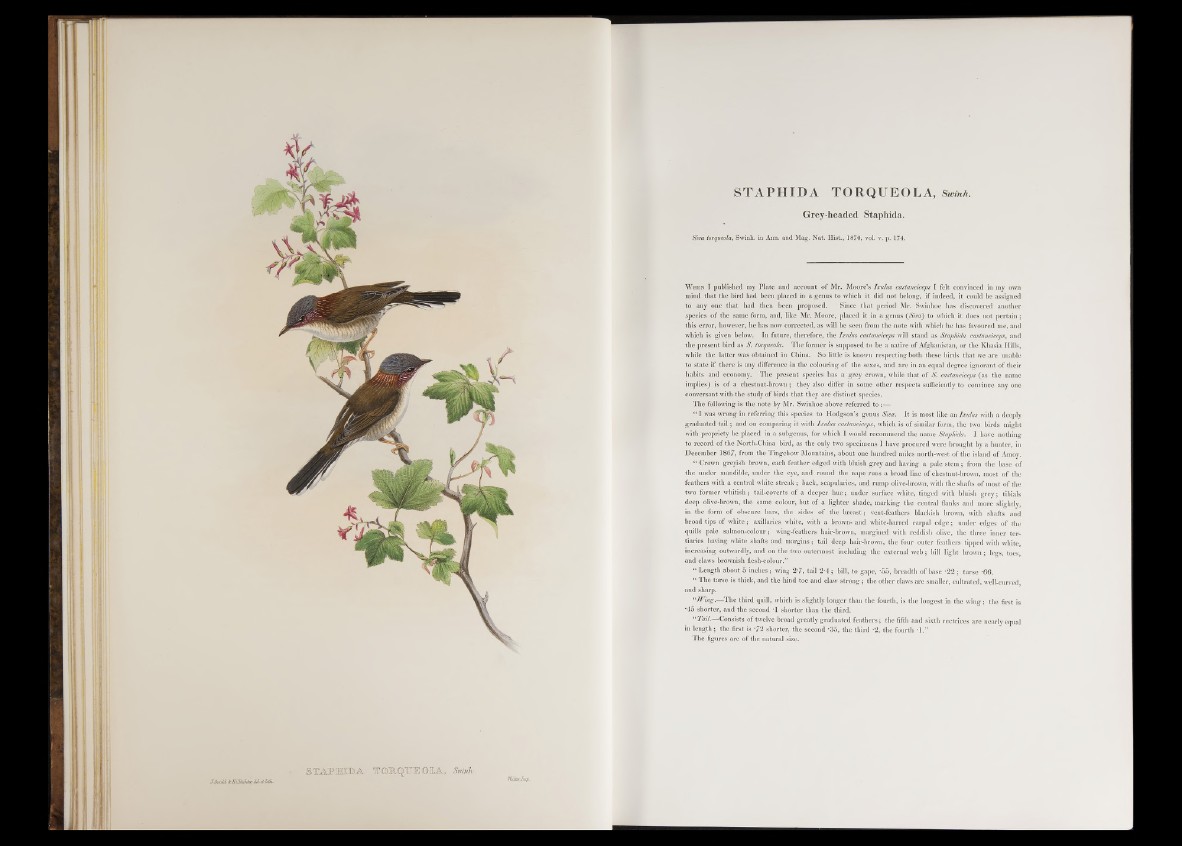
STAPHIDA TORQUEOLA, Swinh.
Grey-headed Staphida.
Siva torqueola, Swinh. in Ann. and Mag. Nat. Hist., 1870, vol. v. p. 174.
W h en I published my Plate and account o f Mr. Moore’s Ixulus castaneiceps I felt convinced in my own
mind that the bird had been placed in a genus to which it did not belong, if indeed, it could be assigned
to any one that had then been proposed. Since that period Mr. Swinhoe has discovered another
species of the same form, and, like Mr. Moore, placed it in a genus (Siva) to which it does not p e rta in ;
this error, however, he has now corrected, as will be seen from the note with which he has favoured me, and
which is given below. In future, therefore, the Ixulus castaneiceps will stand as Staphida castaneiceps, and
the present bird as S. torqueola. The former is supposed to be a native o f Afghanistan, or the Khasia Hills,
while the latter was obtained in China. So little is known respecting both these birds that we are unable
to state if there is any difference in the colouring of the sexes, and are in an equal degree ignorant of their
habits and economy. The present species has a grey crown, while that of S . castaneiceps (as the name
implies) is of a chestnut-brown; they also differ in some other respects sufficiently to convince any one
conversant with the study of birds that they are distinct species.
The following is the note by Mr. Swinhoe above referred t o :—
“ I was wrong in referring this species to Hodgson’s genus Siva. It is most like an Ixulus with a deeply
graduated t a il; and on comparing it with Ixulus castaneiceps, which is of similar form, the two birds might
with propriety be placed in a subgenus, for which I would recommend the name Staphida. I have nothing
to record of the North-China bird, as the only two specimens I have procured were brought by a hunter, in
December 1807, from the Tingchow Mountains, about one hundred miles north-west of the island of Amoy.
“ Crown greyish brown, each feather edged with bluish grey and having a pale s tem ; from the base of
the under mandible, under the eye, and round the nape runs a broad line of chestnut-brown, most of the
feathers with a central white stre ak ; back, scapularies, and rump olive-brown, with the shafts of most of the
two former whitish; tail-coverts of a deeper hue; under surface white, tinged with bluish g rey ; tibials
deep olive-brown, the same colour, but of a lighter shade, marking the central flanks and more slightly,
in the form of obscure bars, the sides of the breast; vent-feathers blackish brown, with shafts and
broad tips of white; axillaries white, with a brown- and white-barred carpal edge; under edges o f the
quills pale salmon-colour;' wing-feathers hair-brown, margined with reddish olive, the three inner ter-
tiaries having white shafts and margins; tail deep hair-brown, the four outer feathers tipped with white,
increasing outwardly, and on the two outermost including the external web; bill light brown ; legs, toes,
and claws brownish flesh-colour.”
“ Length about 5 inches; wing 2 '7, tail 2 -4 ; bill, to gape, -55, breadth of base -22 ; tarse *66.
“ The tarse is thick, and the hind toe and claw stro n g ; the other claws are smaller, cultrated, well-curved,
and sharp.
“Wing.—The third quill, which is slightly longer than the fourth, is the longest in the win g ; the first is
•45 shorter, and the second -1 shorter than the third.
“ Tail.— Consists of twelve broad greatly graduated feathers; the fifth and sixth rectrices are nearly equal
in length; the first is *72 shorter, the second '35, the third -2, the fourth -1.”
The figures are of the natural size.